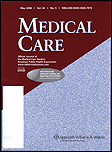
Conducting Physician Mail Surveys on a Limited Budget: A Randomized Trial Comparing $2 Bill Versus $5 Bill Incentives
Abstract
OBJECTIVES: The effects of incentive size on physicians' response rates to a mail survey were determined. METHODS: One thousand US primary care physicians were assigned randomly to receive a survey with either a $5 bill or a $2 bill as an incentive. For each of the two incentive groups, the overall response rate for three mailing waves, the total cost, and the total cost per usable response were measured.
RESULTS: The response rate among those receiving the $5 bill (61%) was 32% higher than the response rate among those receiving the $2 bill (46%); overall costs were slightly higher in the $5 group, but the cost per response for each group was similar ($15.46 versus $14.93). For the same cost, a higher response rate could have been achieved in the $2 group if costs saved from foregoing the third mailing were instead used to increase the incentive for a portion of the subjects.
CONCLUSIONS: A $5 bill incentive yielded a higher response rate among the physicians in this study than did a $2 bill incentive. Moreover, the powerful effect of the incentive size, combined with the consequent decline in the costs of subsequent mailing waves, suggests that resources in a fixed survey budget are allocated more efficiently to increasing the initial incentive rather than to providing a third wave to nonresponders.
Citation:
D.A. Asch, N.A. Christakis, and P.A. Ubel, "Conducting Physician Mail Surveys on a Limited Budget: A Randomized Trial Comparing $2 Bill Versus $5 Bill Incentives" Medical Care, 36(1): 95-99 (January 1998)